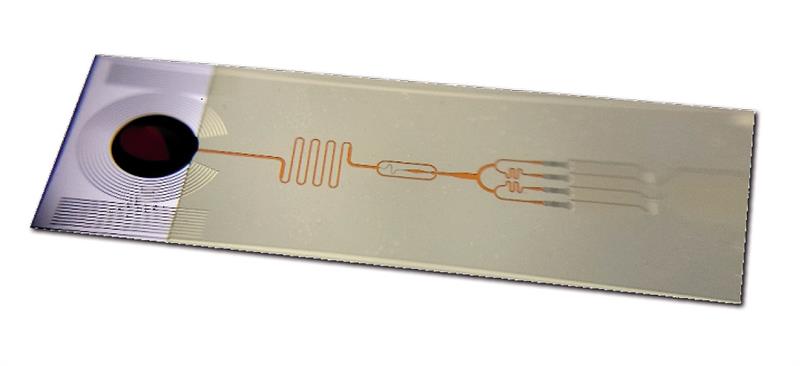In biosciences, IBM has used semiconductor manufacturing technology to create micro-machined structures capable of separating biological particles between 20 and 140nm into different sizes.
These particles, or exosomes, have been described as being the ‘fragments of life’ and are found in bodily fluids such as blood, saliva or urine. According to IBM, by identifying the size of surface proteins and their nucleic acid ‘cargo’, it will be possible to develop techniques to identify the presence, or the developing state, of various diseases.
The structure comprises of an array of pillars positioned at an angle to a flow of liquid. Hydrodynamics means particles of a particular size will travel smoothly between the pillars, but larger or smaller particles will ‘bounce’ off or get swept around in slipstreams and can then be collected. By varying the array’s parameters, different particle sizes can be picked off at different stages.
Experimental biosciences
According to Dr Emmanuel Delamarche, who is leading bioscience research activities at IBM Research in Zurich: “The possibilities of work being conducted not only here at IBM, but also across the sector, are immense and being driven by a real medical need. Health providers are calling for greater portability – hence the development of wearable devices – and want to be able to bring treatments closer to their patients.
“One area of considerable interest is microfluidics. It is a rapidly developing area of research and scientists are continually discovering a range of possibilities for the technology. The work we are doing is at the intersection of engineering, physics, chemistry, nanotechnology and biotechnology.”
Among the projects with which Dr Delamarche is involved are those investigating the role intercellular pathways play in neurodegenerative diseases and those developing techniques for tissue section analysis.
“Microfluidics is set to revolutionise the way patients are diagnosed, monitored and treated and is helping to unlock the potential for point of care testing diagnostics,” he explains. “We will be able to offer faster and more sensitive detection of multiple markers for various diseases. But microfluidics can also be used in pathology, as well as in cell-to-cell interactions, which are especially important when it comes to understanding and treating diseases like Parkinson’s and Alzheimer’s.”
Microfluidics, being used in the development of DNA chips, lab-on-a-chip technology, micro-propulsion and micro-thermal technologies, involves the precise control and manipulation of fluids.
The latest applications employ passive fluid control techniques, like capillary forces, while active microfluidics uses components such as micro pumps or micro valves to manipulate fluids, determining the flow direction or the mode of movement of liquids.

A microfluidic chip developed by IBM
“Beyond point of care, we are also looking at organ-on-a-chip, paper-based microfluidics; tissue engineering and microfabrication,” explains Dr Delamarche.
However, there are a number of challenges when it comes to working with microfluidics. “The problem is not so much making a proof of concept; rather, it’s taking these devices and then making them suitable for manufacture. We are a long way from that point and it remains the key challenge. You are creating micro channels and deploying technology that is hidden in closed structures. The fabrication of these devices requires a closed microfluidic system and we are currently struggling to deliver applications that could be mass produced.”
Bioelectronics
Galvani Bioelectronics, the company created by GSK and Alphabet, is looking to exploit bioelectronics in developing treatments and is set to receive investment of up to £540million over the next seven years.
According to GSK, it will bring together ‘world class drug discovery and development expertise and a deeper understanding of disease biology with leading technical expertise’.
The company will focus on the miniaturisation of low power electronics, device development, data analytics and software development for clinical applications.
Bioelectronics was originally conceived by neurosurgeon and researcher Dr Kevin Tracey, now president of the Feinstein Institute, while he was working with an experimental molecule to combat the effects of stroke damage to the brain.
His team’s work involved injecting the molecule into a rat’s brain to see how it affected swelling, which is an immune system response. The team found the molecule helped to shut down the immune response of the whole body and did this by impacting on the vagus nerve – a long nerve that runs from the brain to the abdomen. By affecting the vagus nerve, the body was found to reduce the production of cytokines, small proteins that have an important role in cell signalling, helping to block inflammation.

The result suggested it might be possible to replace drugs with treatments that manipulated a patient’s nerves.
As a result, Tracey focused his research efforts into the field of bioelectronics and the development of medicines based on using electrical impulses to modulate the body’s neural circuits, which regulate most of the body’s organs and functions.
At the heart of bioelectronics is the concept that, by mapping the neural signatures of certain diseases accurately, tiny electrodes that stimulate or inhibit malfunctioning neural pathways could restore health.
"Microfluidics is set to revolutionise the way in which patients are diagnosed, monitored and treated." Dr Emmanuel Delamarche
In theory, these treatments will be cheaper to administer and the patient will not have to contend with having their systems flooded with medicines.
According to GSK, it will be possible to programme these tiny devices to read and then modify electrical signals passing along nerves in the body, correcting irregular or altered impulses that are often associated with a broad range of diseases.
While the vision of bioelectronics medicine may be some way, these tiny devices – likely to be no bigger than a grain of sand – could enable doctors to treat diseases with far greater precision and with fewer side effects than are often associated with conventional medicines.
While our understanding of the nervous system has grown dramatically over the past 300 years, the ability to influence and treat disease in this way remains limited. And while the use of electrical impulses isn’t new – deep brain simulation using electrical impulses is used to treat Parkinson’s, for example – it tends, at present, to treat large areas of tissue indiscriminately, rather than targeting specific groups of neurons.
While bioelectronics might not be able to treat infectious diseases or cancer, it should be possible to stimulate the nerves to boost aspects of the immune system and to even slow the progression of the disease.
Companies like GSK and IBM are among a growing number of organisations working on techniques and devices offering the prospect of treatments targeted at specific circuits within the nervous system, delivering more effective, less invasive forms of treatment with fewer side effects.
Could we be looking at the demise of the drug industry as we know it?













